Research on Temporal and Spatial Distribution of Carbon Emissions from Urban Buses Based on Big Data Analysis
Abstract
1. Introduction
2. Research Methods
2.1. Measurement Method of Carbon Emissions
2.2. Carbon Emission Model of Motor Vehicles
- Emission model based on average speed
- 2.
- Emission model based on driving conditions
2.3. Traffic Big Data Analysis
3. Variable Description and Analysis
3.1. Data Sources
- The GPS data of buses
- 2.
- Data of buses’ characteristics
- 3.
- Data of buses’ routes
3.2. Preprocessing of Data
- Data elimination
- 2.
- Data filtering
3.3. Carbon Emissions’ Measurement of Urban Buses—Taking Sanya as an Example
3.3.1. Carbon Emission Model’s Selection and Data Preprocessing for Vehicles
3.3.2. Measurement of Carbon Emissions under Driving Conditions
3.3.3. Measurement of Carbon Emissions at Idle Speed
3.3.4. Calculation of Total Carbon Emissions during Operation
3.4. Carbon Emission Visualization Method
3.4.1. Analysis of Linear Density and Point Density
3.4.2. Analysis of Nuclear Density
4. Results and Discussions of the Spatial–Temporal Analysis of Carbon Emissions
4.1. Analysis of Time Characteristics for Carbon Emissions
4.1.1. Comparative Analysis of Carbon Emissions in Different Periods
4.1.2. Comparative Analysis of Carbon Emissions on Working Days and Rest Days
4.1.3. Temporal Comparative Analysis of Carbon Emissions for Different Energy Types
4.2. Analysis of Spatial Characteristics of Carbon Emissions
4.2.1. Spatial Comparative Analysis of Carbon Emission on Working Days and Rest Days
4.2.2. Spatial Comparative Analysis of Carbon Emissions on Different Lines
5. Conclusions and Suggestions
5.1. Conclusions
- By using the data of GPS track and buses’ management of Sanya’ urban buses, this paper combines the energy consumption attributes, operating conditions, and buses’ emission models to achieve the calculation of buses’ CO2 emissions at different track points in a day. Through the calculation, the spatial–temporal distribution of urban buses’ carbon emissions can be more accurately excavated.
- After visualizing the temporal and spatial distribution characteristics of buses’ carbon emissions in Sanya, it is found that from the temporal perspective, the distribution of buses’ carbon emissions at different times of the day in a week is similar to the daily travel characteristics of residents. The carbon emissions at the peak time are significantly higher than the off-peak time, and there will also be peak bands. Compared with the weekdays, the morning peak on the weekend occurs later, and the change of carbon emissions is relatively stable within a day. Through the analysis of different energy types of buses in different periods, it is found that the carbon emissions of natural gas and diesel buses are significantly higher than those of electric buses in the daytime, and the carbon emissions of diesel and electric buses are higher than those of natural gas buses after 18:00 p.m. From the perspective of space, the distribution of carbon emissions in different time periods during the weekdays and the weekends is also different. The road sections with higher carbon emissions are mainly concentrated in residential areas, offices, and schools in the early peak period, and mainly in leisure and entertainment areas in the late peak period. The carbon emissions on different lines are also different in the spatial distribution. The lines with high station density are mostly concentrated in the central area of the city, and their emissions are higher than those with low station density and distributed at the edge of the city.
5.2. Suggestions
- Optimize the energy structure of buses
- Optimize the layout of buses’ network
Author Contributions
Funding
Institutional Review Board Statement
Informed Consent Statement
Data Availability Statement
Acknowledgments
Conflicts of Interest
References
- Zhu, J.; Liu, X.M.; Chu, Z.P. Analysis on the development ways of urban low-carbon transportation. Ecol. Econ. 2016, 32, 76–81. [Google Scholar]
- Long, Y.; Sun, L.J.; Tao, S. Literature review on urban buses’ data of smart card. Urban Plan. Forum. 2015, 03, 70–77. [Google Scholar]
- Sun, Z.; Hao, P.; Ban, X.J.; Yang, D. Trajectory-based vehicle energy/emissions estimation for signalized arterials using mobile sensing data. Transp. Res. Part. D Transp. Environ. 2015, 34, 27–40. [Google Scholar] [CrossRef]
- Luo, X.; Dong, L.; Dou, Y.; Zhang, N.; Ren, J.; Li, Y.; Sun, L.; Yao, S. Analysis on spatial-temporal features of taxis’ emissions from big data informed travel patterns: A case of Shanghai, China. J. Clean. Prod. 2016, 142, 926–935. [Google Scholar] [CrossRef]
- Du, Y.; Wu, J.; Yang, S.; Zhou, L. Predicting vehicle fuel consumption patterns using floating vehicle data. J. Environ. Sci. 2017, 59, 24–29. [Google Scholar] [CrossRef]
- Weng, J.C.; Liang, Q.; Qiao, G.L.; Chen, Z.H.; Rong, J. Taxi fuel consumption and emissions estimation model based on the reconstruction of driving trajectory. Adv. Mech. Eng. 2017, 9, 209–216. [Google Scholar] [CrossRef]
- Shan, X.N.; Chen, X.H.; Jia, W.J.; Ye, J.H. Evaluating urban bus emission characteristics based on bocalized MOVES using sparse GPS Data in Shanghai, China. Sustainability 2019, 11, 2936. [Google Scholar] [CrossRef]
- Sui, Y.; Zhang, H.R.; Shang, W.L.; Sun, R.C.; Wang, C.Y.; Ji, J.; Song, X.; Shao, F.J. Mining urban sustainable performance: Spatio-temporal emission potential changes of urban transit buses in post-COVID-19 future. Appl. Energy 2020, 280, 115966. [Google Scholar] [CrossRef]
- Zhou, Y.; Huang, R.H.; Tang, E.B. Dynamic calculation method of carbon emissions of urban road traffic based on GPS+GIS+ GSM. J. Nanchang Hangkong Univ. (Soc. Sci.) 2016, 18, 35–41. [Google Scholar]
- Guo, Y.Y. Research on Emission Factors of Motor Vehicles in Shenzhen Based on MOVES Model. Master’s Thesis, Harbin Institute of Technology, Harbin, China, 2014. [Google Scholar]
- Niu, T.L. Research on Emission Inventory of High-Resolution Road Network in Nanjing Based on Intelligent Transportation Big Data. Master’s Thesis, Tsinghua University, Beijing, China, 2017. [Google Scholar]
- Xu, L.; Wang, L.; Liu, Y.; Song, G.H.; Li, C.X.; Zhai, Z.Q. Calculation model of buses’ energy consumptions and carbon emissions based on multi-source data. J. Transp. Syst. Eng. Inf. Technol. 2020, 20, 174–181. [Google Scholar]
- Andrienko, G.; Andrienko, N. Spatio-temporal Aggregation for Visual Analysis of Movements. In Proceedings of the IEEE Symposium on Visual Analysis Science and Technology, Columbus, OH, USA, 19–24 October 2008; pp. 51–58. [Google Scholar] [CrossRef]
- Nam, D.; Hyun, K.; Kim, H.; Ahn, K.; Jayakrishna, R. Grid Cell Based Taxi Ridership Analysis Using Large Scale GPS Data. In Proceedings of the Transportation Research Board 95th Annual Meeting, Washington, DC, USA, 10–14 January 2016. [Google Scholar]
- Zhao, P.; Kwan, M.P.; Qin, K. Uncovering the spatiotemporal patterns of CO2 emissions by taxis based on Individuals’ daily travel. J. Transp. Geogr. 2017, 62, 122–135. [Google Scholar] [CrossRef]
- Wang, Z.H. Research on Spatial and Temporal Accessibility Distribution of Urban Multimodal Traffic. Master’s Thesis, Shenzhen University, Shenzhen, China, 2016. [Google Scholar]
- Xu, Y.J. Analysis of Spatial-Temporal Characteristics of Residents’ Travel Based On Taxi Track Data. Master’s Thesis, Shandong University of Science and Technology, Qingdao, China, 2017. [Google Scholar]
- Wang, G.; Sun, Y.L.; Wang, X.Z.; Li, J.Z. Analysis and application of spatial-temporal characteristics of transportation in Wuhan City based on typical dynamic data. Traffic Transp. 2019, 35, 29–32. [Google Scholar]
- Zheng, M.L.; Yang, H.L. Spatial-temporal changes and factors of carbon emissions from cargo transport at the municipal scale. Sci. Surv. Mapp. 2019, 05, 76–84. [Google Scholar]
- Ning, X.J.; Zhang, J.P.; Qin, Y.C.; Lu, F.X. Temporal and spatial characteristics of urban residents’ traffic carbon emissions in Zhengzhou. Resour. Sci. 2014, 36, 1021–1028. [Google Scholar]
- Sun, G.J. Characteristics and Emission Reduction Measures of PM2.5 and NOX from Motor Vehicles. Doctoral Thesis, Zhejiang University, Hangzhou, China, 2013. [Google Scholar]
- Gao, Z.F. Study on the Coordinated Treatment of Carbon Emissions and Air Pollution Emissions in the Yangtze River Delta Urban Agglomeration. Master’s Thesis, Zhejiang University of Technology, Hangzhou, China, 2019. [Google Scholar]
- Schipper, L.; Grubb, M. On the rebound feedback between energy intensities and energy uses in IEA countries. Energy Policy 2000, 28, 367–388. [Google Scholar] [CrossRef]
- Sun, J.; Zhang, Y.; Xue, R.; Zhang, Y. Formation mechanism of carbon emission from urban road traffic based on mobile monitoring: A case study of Shanghai. China J. Highw. Transp. 2017, 30, 122–131. [Google Scholar]
- Halevi, G.; Moed, H. The evolution of big data as a research and scientific topic: Overview of the literature. Res. Trends 2012, 30, 3–6. [Google Scholar]
- Hey, T.; Gannon, D.; Pinkelman, J. The future of data-intensive science. Computer 2012, 45, 81–82. [Google Scholar] [CrossRef]
- Dong, Y. Research on dynamic visualization of buses’ GPS track based on Web. Innovative technology Enabling planning Wisdom for the Future. In Proceedings of 2021 China Urban Planning Informatization Annual Conference, Online conference, 10 December 2021; pp. 138–143. [Google Scholar] [CrossRef]
- Wang, X. Research on Key Problems of Urban Taxi Operation Service Based On Large Scale GPS Data. Doctoral Dissertation, Jilin University, Changchun, China, 2021. [Google Scholar]
- Zhao, Z.X.; Shao, C.F.; Chen, Y. Assessment of carbon emission reduction effect of private electric cars in the Whole Life Cycle in Chinese Provinces. J. Henan Sci. Technol. 2021, 34, 2076–2085. [Google Scholar]
- Chu, R.S.; Wu, T.L.; He, W.C.; Cao, G.H. Research on carbon-emission model of toll stations of expressways under dual carbon targets. J. Henan Sci. Technol. 2021, 40, 120–123. [Google Scholar]
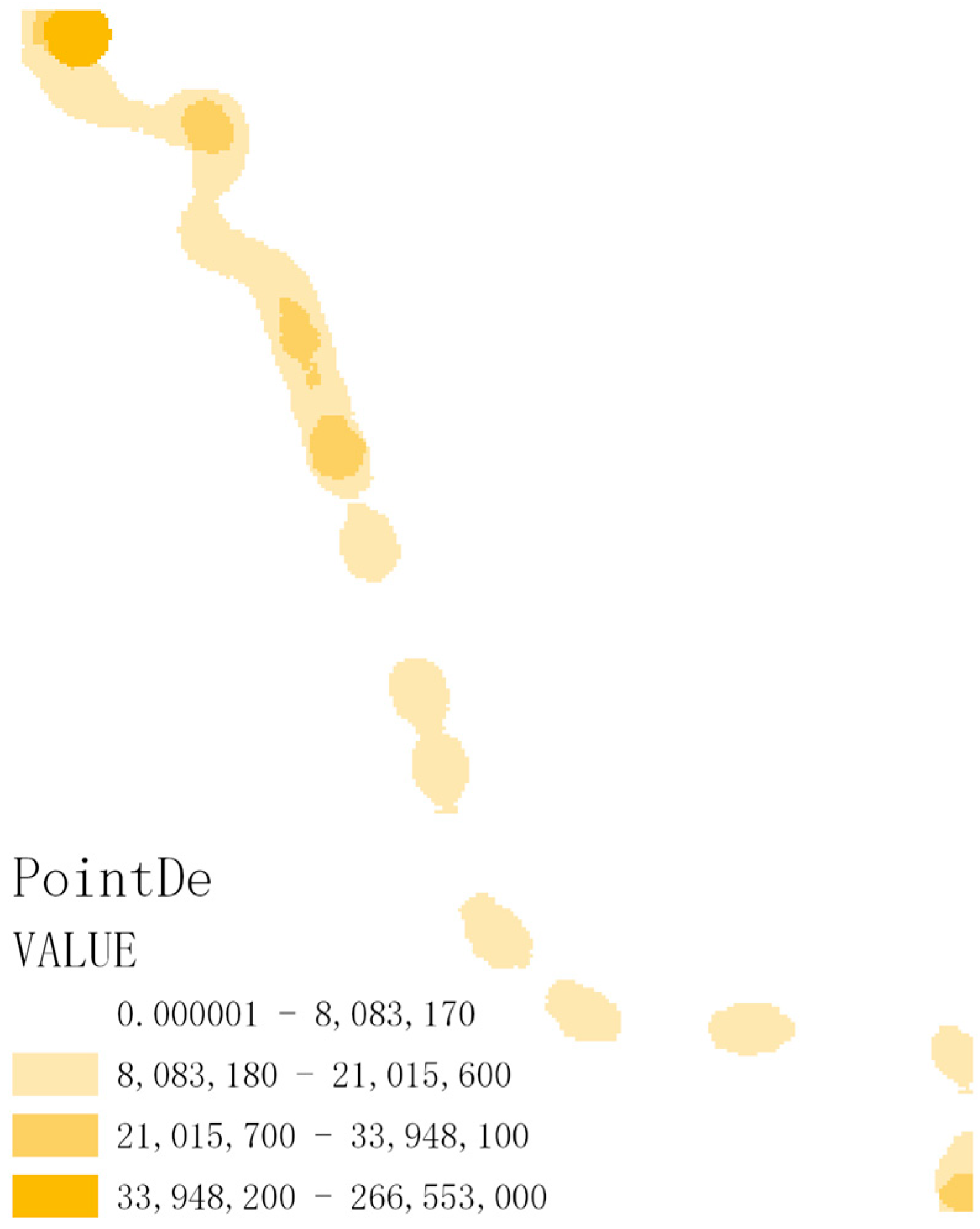
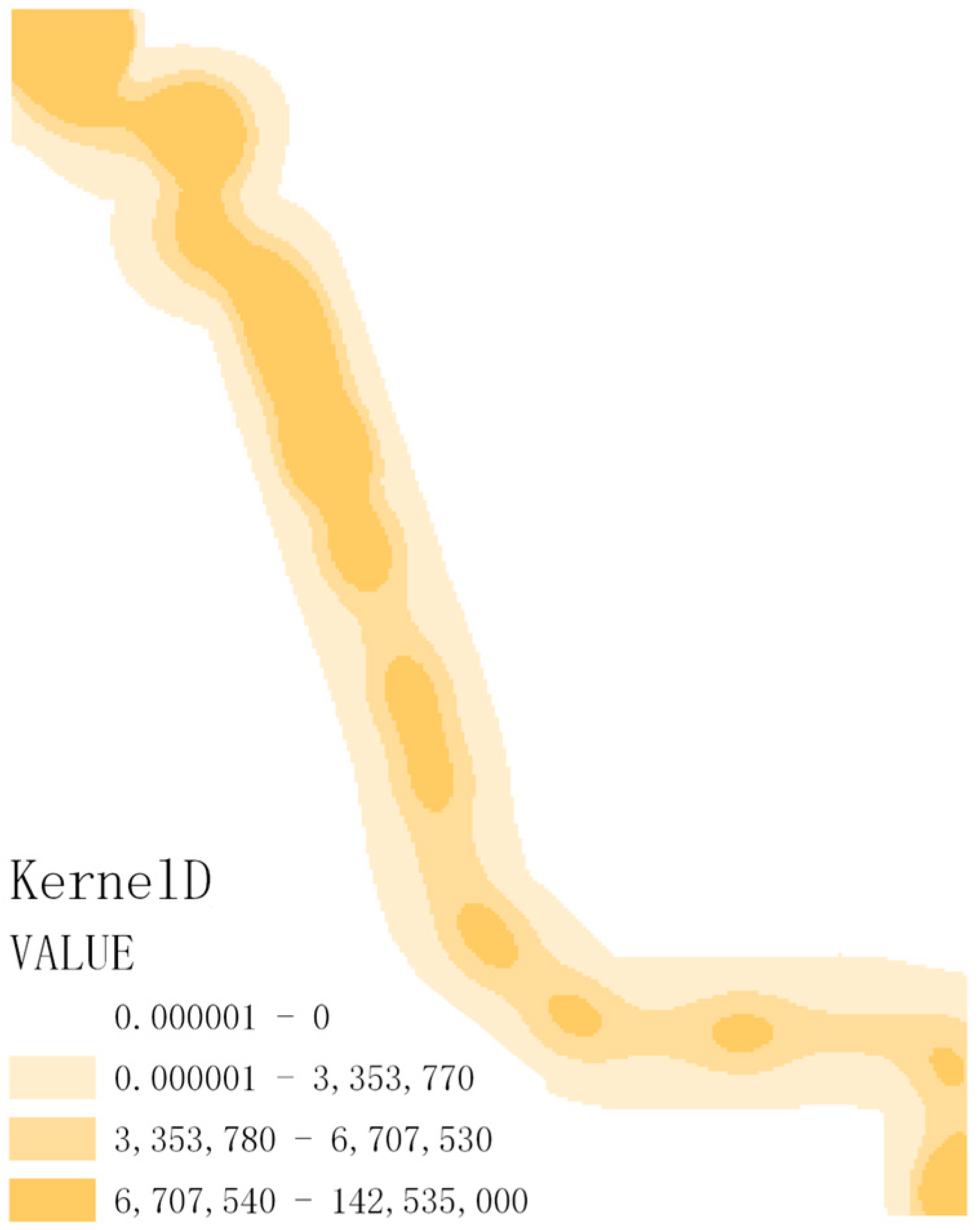
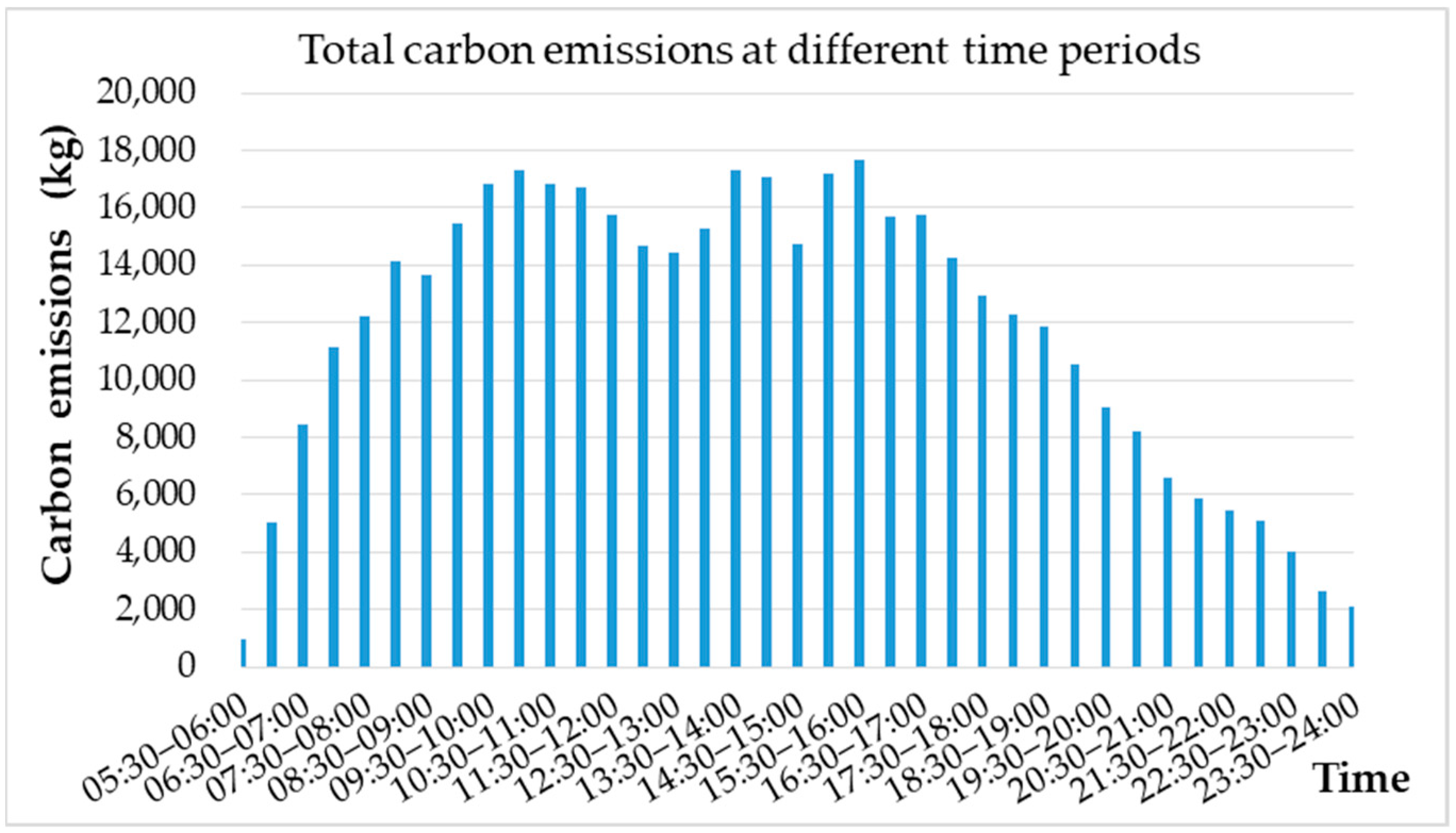
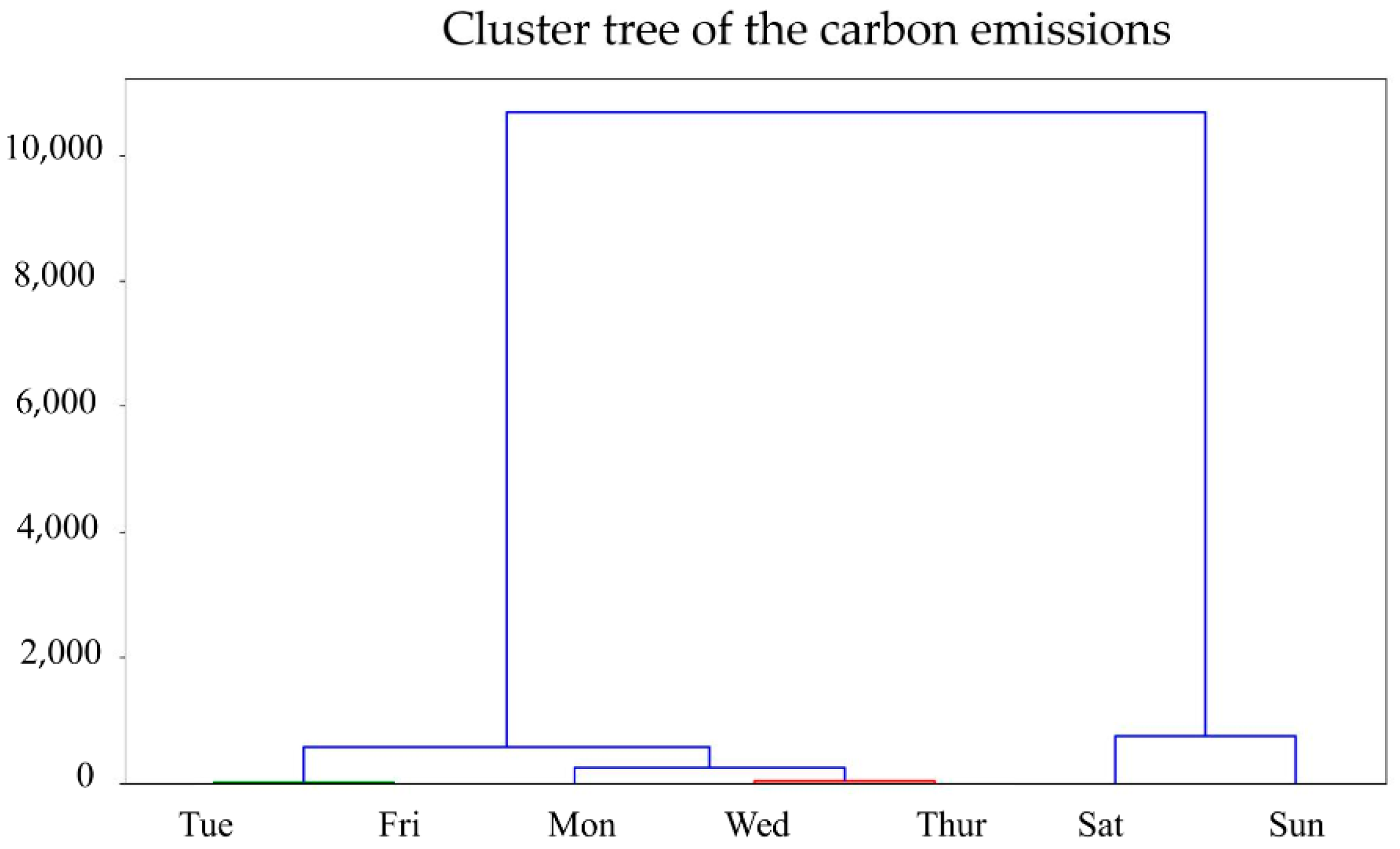
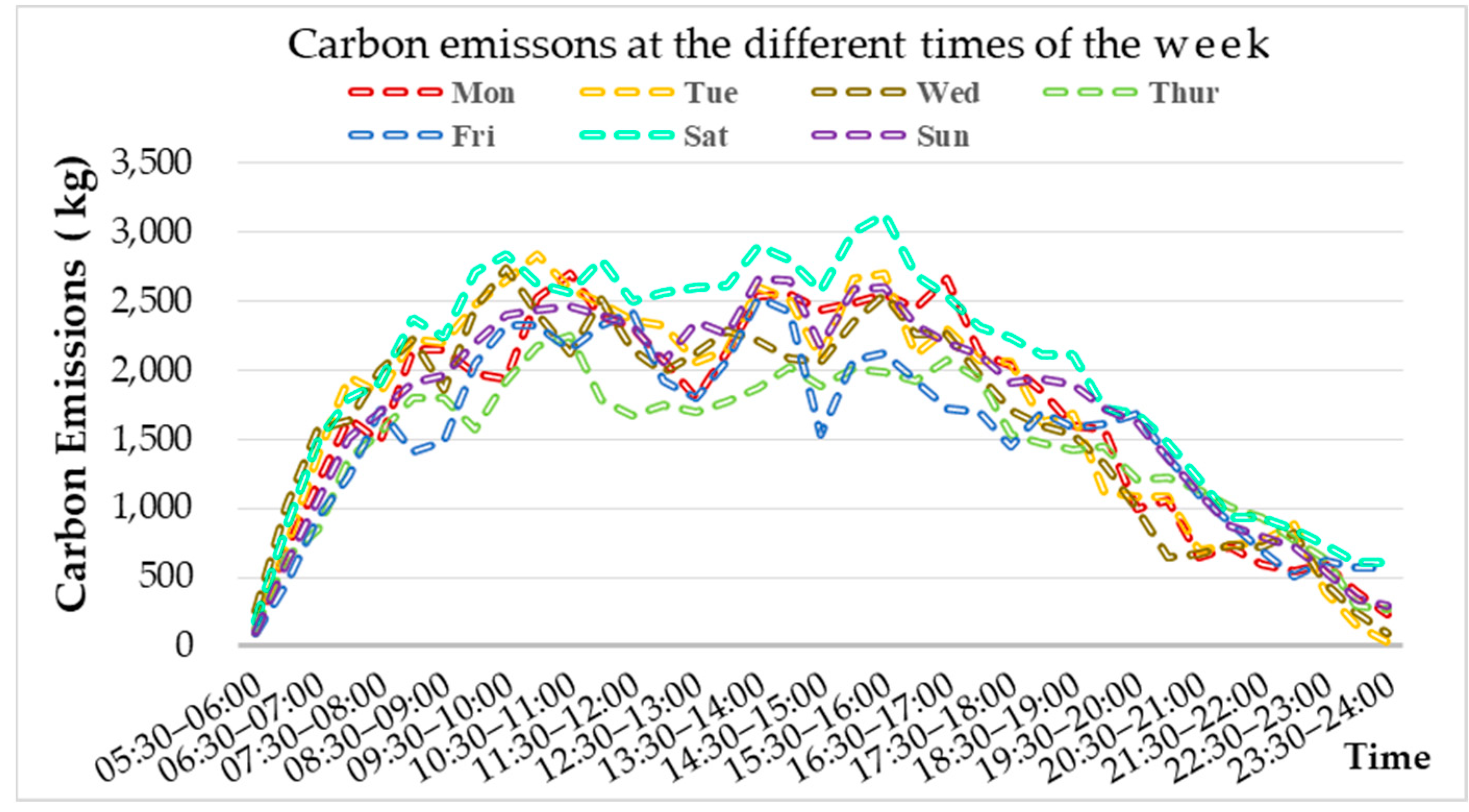



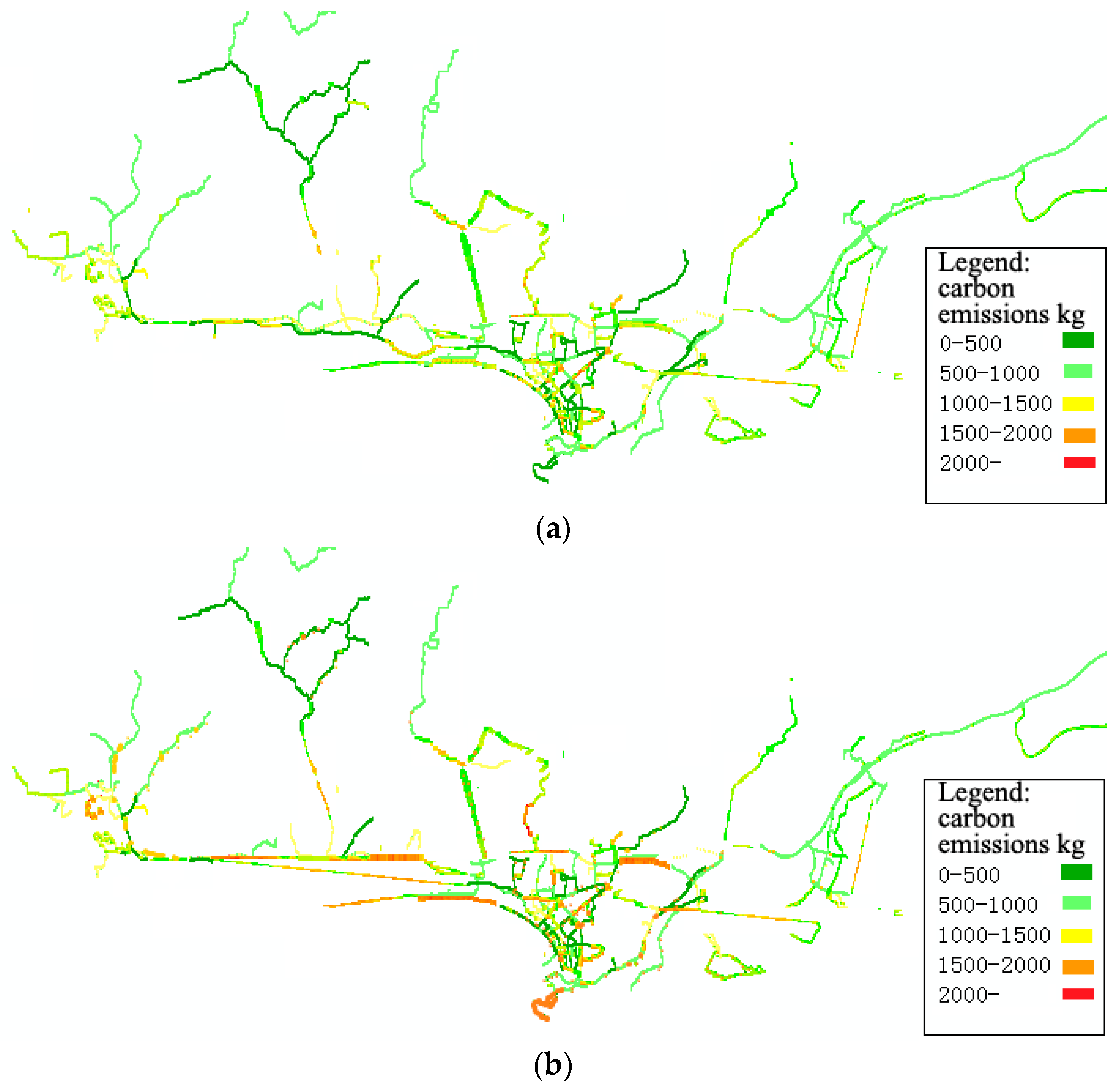
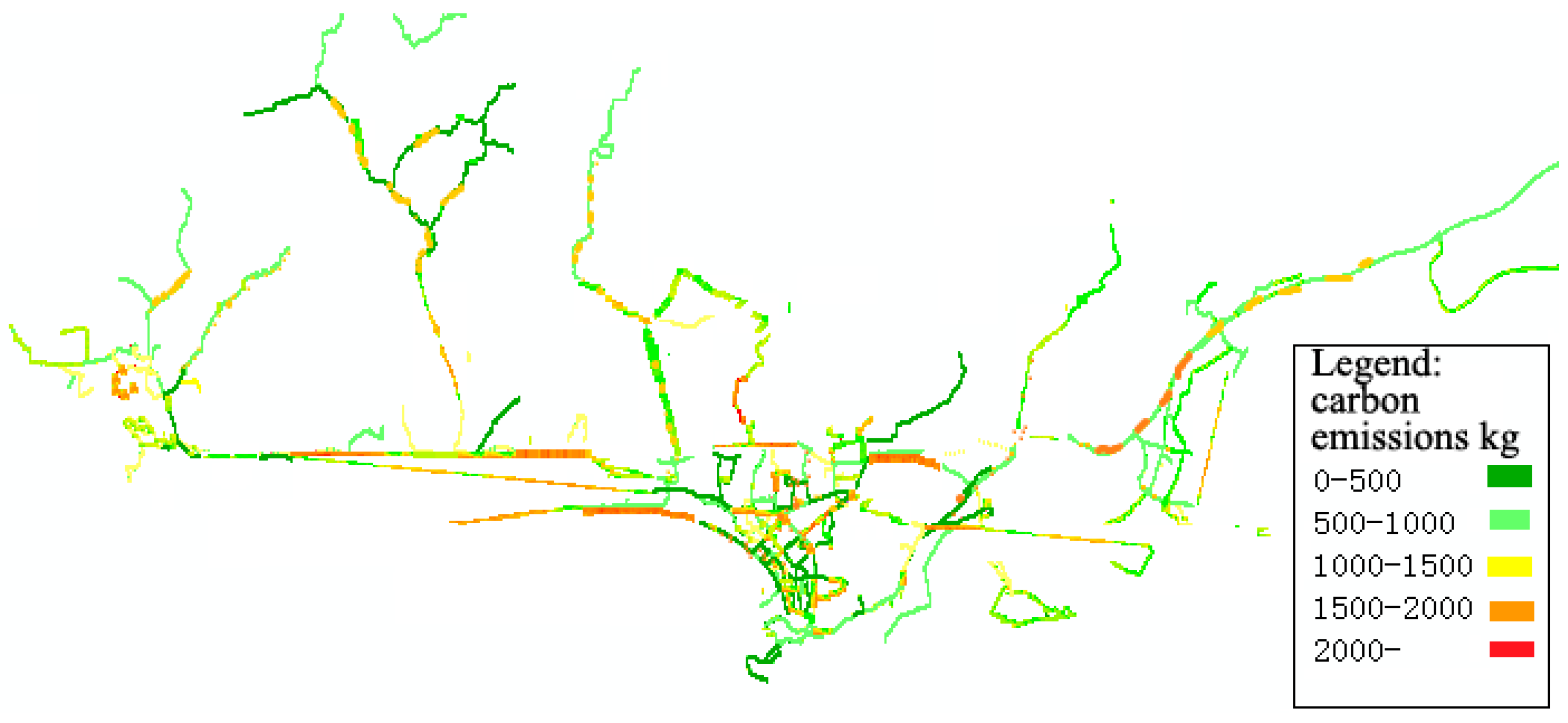
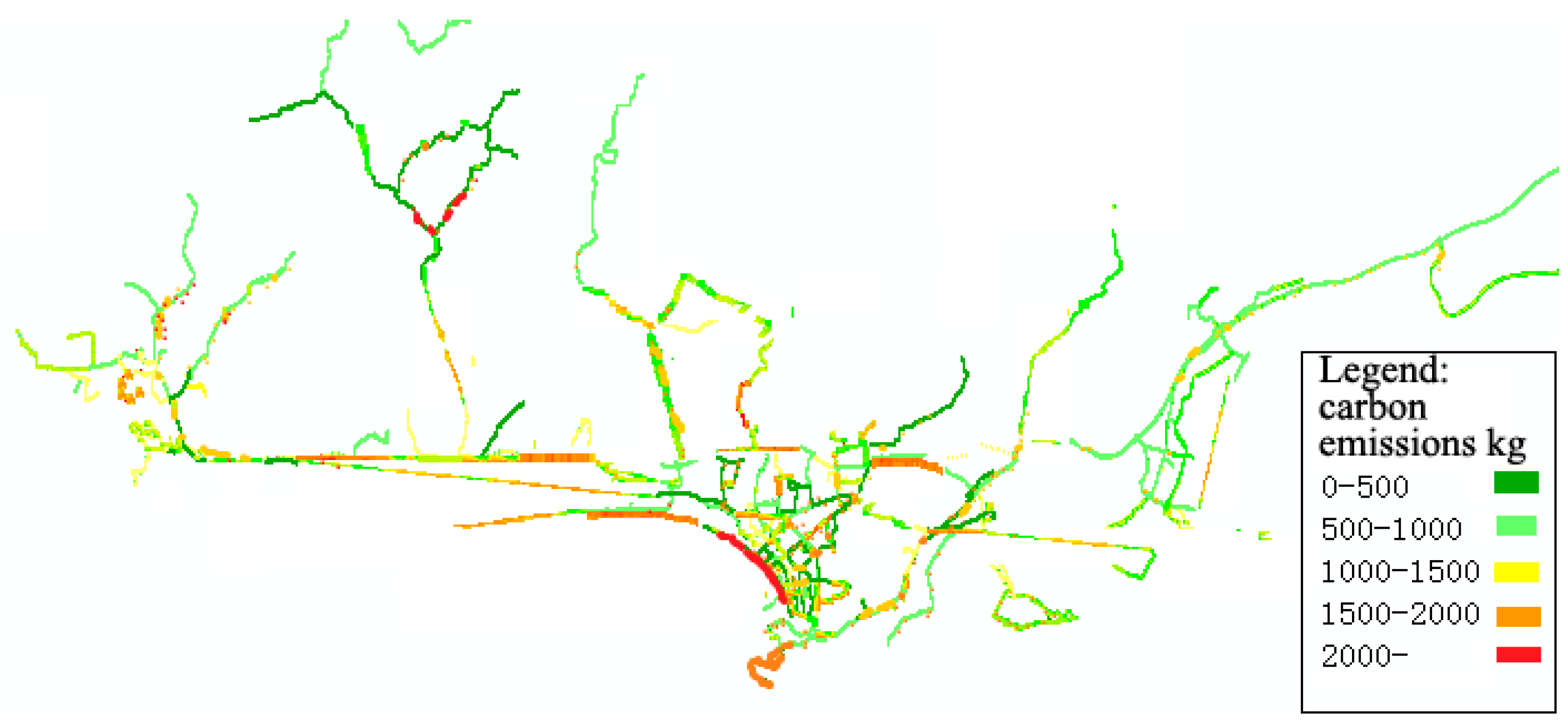
| No. | Field Name | Illustration | Example |
|---|---|---|---|
| 1 | GPS acquisition time | Acquisition time of GPS data (accurate to one track point every 6 s) | 15 March 2021 09:03:20:000 |
| 2 | Longitude | Longitude coordinate of current buses’ operation | 109.16589884507853 |
| 3 | Latitude | Latitude coordinate of current vehicle operation | 18.370064237983335 |
| 4 | Speed | Instantaneous running speed of vehicle (km/h) | 19.00 |
| 5 | Equipment line no. | Running lines for buses | 501 |
| 6 | Equipment no. | Numbers of buses | 532 |
| 7 | Station sequence | Bus stops’ ordinal | 3 |
| 8 | Type of pulling in and out | 1: pull in 2: pull out | 1 |
| No. | Field Name | Illustration | Example |
|---|---|---|---|
| 1 | Self-number | Corresponding equipment number in the GPS data, namely, numbers of buses | 532 |
| 2 | Types of energies | Including: diesel, natural gas, electric | Diesel |
| 3 | Engine number | The engine models of the current buses | FGGJAG00744 |
| 4 | Length of buses | Length of the current buses (length × width × height mm) | 5990 × 2250 × 2995 |
| 5 | License plate | The brands of buses | Brand of Ankai |
| No. | Field Name | Illustration | Example |
|---|---|---|---|
| 1 | Name of route | Names of buses’ routes | Route 1 |
| 2 | Starting station | Starting station of current route | Port office |
| 3 | Terminal | Terminal of current route | Tropical Ocean University |
| 4 | Names of station | Name of the station of the current running bus | Yifang Department Store |
| 5 | Station’s sequence | Sequence of the current on-line station | 3 |
| Upload Time of GPS | Longitude | Latitude | Speed (km/h) | Stations’ No. | Types of Inbound and Outbound | States of Vehicles |
|---|---|---|---|---|---|---|
| 15 March 2021 08:12:19:000 | 109.17387650952952 | 18.35098273675489 | 22.00 | 21 | 1 | 2 |
| 15 March 2021 08:12:25:000 | 109.17385809246032 | 18.35103619638755 | 22.00 | 2 | ||
| 15 March 2021 08:12:31:000 | 109.17376167453858 | 18.35133468978279 | 19.00 | 2 | ||
| 15 March 2021 08:12:37:000 | 109.17372673727624 | 18.35145787693310 | 0.00 | 1 | ||
| 15 March 2021 08:12:43:000 | 109.17372673727624 | 18.35145787693310 | 0.00 | 1 | ||
| 15 March 2021 08:12:49:000 | 109.17372673727624 | 18.35145787693310 | 0.00 | 1 | ||
| 15 March 2021 08:12:55:000 | 109.17372673727624 | 18.35145787693310 | 0.00 | 1 | ||
| 15 March 2021 08:13:01:000 | 109.17372673727624 | 18.35145787693310 | 0.00 | 1 | ||
| 15 March 2021 08:13:07:000 | 109.17372511287743 | 18.35147632101555 | 7.00 | 2 | ||
| 15 March 2021 08:13:13:000 | 109.17364196381608 | 18.35168800810271 | 20.00 | 2 | ||
| 15 March 2021 08:13:19:000 | 109.1735054592305 | 18.35205166366514 | 23.00 | 21 | 2 | 2 |
| Energy | Conversion Coefficient to Standard Coal (kg/kg, m3) | Average Low Calorific Value (kJ/kg, m3) | Carbon Content per Unit Calorific Value (kg-c/GJ) | Carbon Oxidation Rate (%) | Carbon Emission Coefficient (kg-CO2 or kg-CO2/m3) |
|---|---|---|---|---|---|
| Raw coal | 0.7143 | 20,908 | 26.37 | 0.94 | 1.9003 |
| Diesel oil | 1.4571 | 42,652 | 20.2 | 0.98 | 3.0959 |
| Natural gas | 1.33 | 38,931 | 15.32 | 0.99 | 2.1650 |
| power | - | - | - | - | - |
| No. | Brand | Percentage | Length (mm) | Energy Consumption per 100 km (L/100 km) |
|---|---|---|---|---|
| 1 | Ankai | 25.53% | 5990 × 2250 × 2995 | 14 |
| 2 | Ankai | 2.43% | 9995 × 2500 × 3220 | 28 |
| 3 | Golden Dragon | 2.74% | 10,990 × 2500 × 3600 | 18.7 |
| 4 | Golden Dragon | 27.05% | 10,510 × 2500 × 3300 | 14.3 |
| 5 | Yutong | 3.04% | 6610 × 2240 × 2990 | 18 |
| 6 | Yutong | 2.43% | 10,185 × 2500 × 3220 | 25.5 |
| 7 | Kinglong | 3.04% | 8495 × 2480 × 3388 | 18.5 |
| 8 | Kinglong | 5.47% | 10,490 × 2480 × 3404 | 20.6 |
| 9 | Kinglong | 5.17% | 10,500 × 2500 × 3370 | 18.5 |
| 10 | Kinglong | 23.10% | 10,700 × 2500 × 3300 | 16.9 |
| No. | Brand | Percentage | Length (mm) | Energy Consumption per 100 km (kwh/100 km) |
|---|---|---|---|---|
| 1 | Ankai | 3.78% | 10,990 × 2500 × 3590 | 54.64 |
| 2 | Kinglong | 4.72% | 8545 × 2450 × 3145 | 38.76 |
| 3 | CRRC | 6.46% | 10,500 × 2500 × 3280 | 53.00 |
| 4 | BYD | 14.65% | 10,690 × 2500 × 3580 | 44.08 |
| 5 | BYD | 4.41% | 4460 × 1720 × 1875 | 13.97 |
| 6 | Winnerway | 11.34% | 8560 × 2410 × 3080 | 38.67 |
| 7 | Winnerway | 4.72% | 10,450 × 2480 × 3220 | 51.68 |
| 8 | Skywell | 3.15% | 8010 × 2160 × 2860 | 38.68 |
| 9 | Skywell | 1.57% | 8490 × 2460 × 3120 | 44.30 |
| 10 | Zhongtong | 2.52% | 6645 × 2280 × 3000 | 28.20 |
| 11 | Zhongtong | 1.89% | 8600 × 2489 × 3280 | 37.79 |
| 12 | Zhongtong | 5.20% | 10,480 × 2500 × 3280 | 52.73 |
| 13 | Yutong | 5.35% | 6395 × 2065 × 2930 | 30.66 |
| 14 | Yutong | 8.50% | 8050 × 2350 × 3105 | 46.83 |
| 15 | Yutong | 3.15% | 8995 × 2500 × 3450 | 42.57 |
| 16 | Yutong | 10.71% | 10,500 × 2500 × 3215 | 54.81 |
| 17 | Yutong | 6.30% | 10,690 × 2500 × 3430 | 52.36 |
| 18 | Yutong | 1.57% | 12,300 × 2550 × 4140 | 64.83 |
| No. | Brand | Percentage | Length of the Brand (mm) | Energy Consumption of LNG per 100 km (kg/100 km) | Energy Consumption of LNG of per 100 km (L/100 km) |
|---|---|---|---|---|---|
| 1 | Yutong | 20.26% | 8545 × 2500 × 3200 | 27.45 | 61.00 |
| 2 | Yutong | 3.92% | 9295 × 2500 × 3200 | 32.08 | 71.29 |
| 3 | Yutong | 6.54% | 10,490 × 2500 × 3550 | 32.08 | 71.29 |
| 4 | Yutong | 13.07% | 10,490 × 2500 × 3580 | 32.08 | 71.29 |
| 5 | Yutong | 24.83% | 10,500 × 2500 × 3200 | 32.08 | 71.29 |
| 6 | Ankai | 24.83% | 5900 × 2250 × 2995 | 21.18 | 47.07 |
| 7 | Kinglong | 6.54% | 8490 × 2450 × 3080 | 27.45 | 61.00 |
| Mon | Tue | Wed | Thu | Fri | Sat | Sun | |
|---|---|---|---|---|---|---|---|
| Monday | 1.000 | 0.995 | 0.981 | 0.993 | 0.972 | 0.876 | 0.815 |
| Tuesday | 0.995 | 1.000 | 0.985 | 0.998 | 0.984 | 0.911 | 0.855 |
| Wednesday | 0.981 | 0.985 | 1.000 | 0.987 | 0.966 | 0.923 | 0.879 |
| Thursday | 0.993 | 0.998 | 0.987 | 1.000 | 0.988 | 0.919 | 0.867 |
| Friday | 0.972 | 0.985 | 0.966 | 0.988 | 1.000 | 0.935 | 0.890 |
| Saturday | 0.876 | 0.911 | 0.923 | 0.919 | 0.935 | 1.000 | 0.989 |
| Sunday | 0.815 | 0.855 | 0.879 | 0.867 | 0.890 | 0.989 | 1.000 |
Disclaimer/Publisher’s Note: The statements, opinions and data contained in all publications are solely those of the individual author(s) and contributor(s) and not of MDPI and/or the editor(s). MDPI and/or the editor(s) disclaim responsibility for any injury to people or property resulting from any ideas, methods, instructions or products referred to in the content. |
© 2023 by the authors. Licensee MDPI, Basel, Switzerland. This article is an open access article distributed under the terms and conditions of the Creative Commons Attribution (CC BY) license (https://creativecommons.org/licenses/by/4.0/).
Share and Cite
Long, Y.; Zhu, C.; Zhang, C.; Pan, R. Research on Temporal and Spatial Distribution of Carbon Emissions from Urban Buses Based on Big Data Analysis. Atmosphere 2023, 14, 411. https://doi.org/10.3390/atmos14020411
Long Y, Zhu C, Zhang C, Pan R. Research on Temporal and Spatial Distribution of Carbon Emissions from Urban Buses Based on Big Data Analysis. Atmosphere. 2023; 14(2):411. https://doi.org/10.3390/atmos14020411
Chicago/Turabian StyleLong, Yan, Changzheng Zhu, Cong Zhang, and Renjie Pan. 2023. "Research on Temporal and Spatial Distribution of Carbon Emissions from Urban Buses Based on Big Data Analysis" Atmosphere 14, no. 2: 411. https://doi.org/10.3390/atmos14020411
APA StyleLong, Y., Zhu, C., Zhang, C., & Pan, R. (2023). Research on Temporal and Spatial Distribution of Carbon Emissions from Urban Buses Based on Big Data Analysis. Atmosphere, 14(2), 411. https://doi.org/10.3390/atmos14020411







